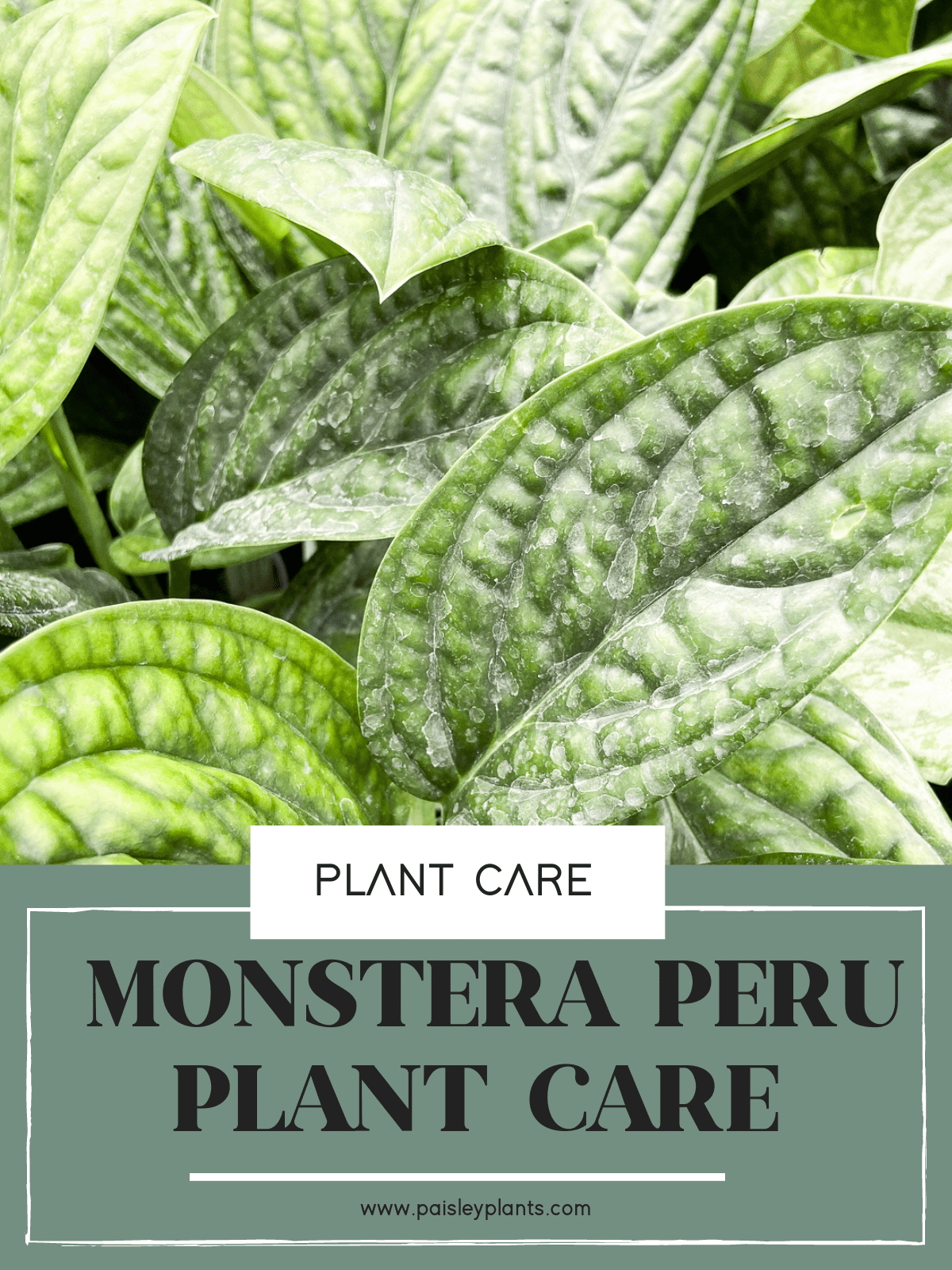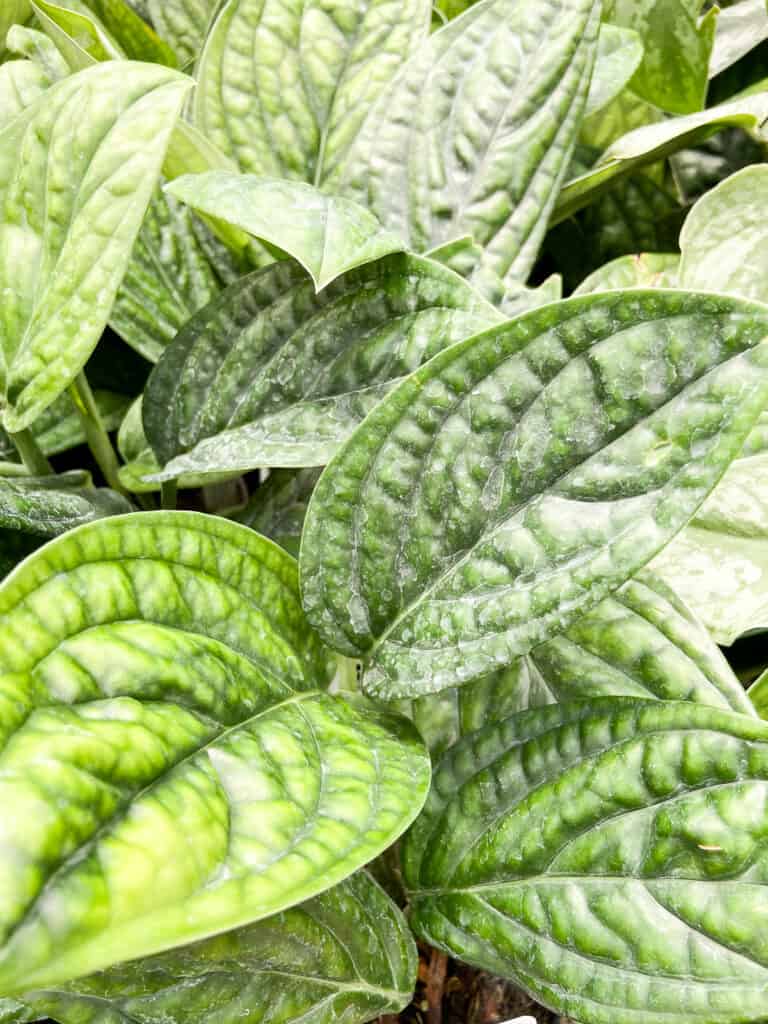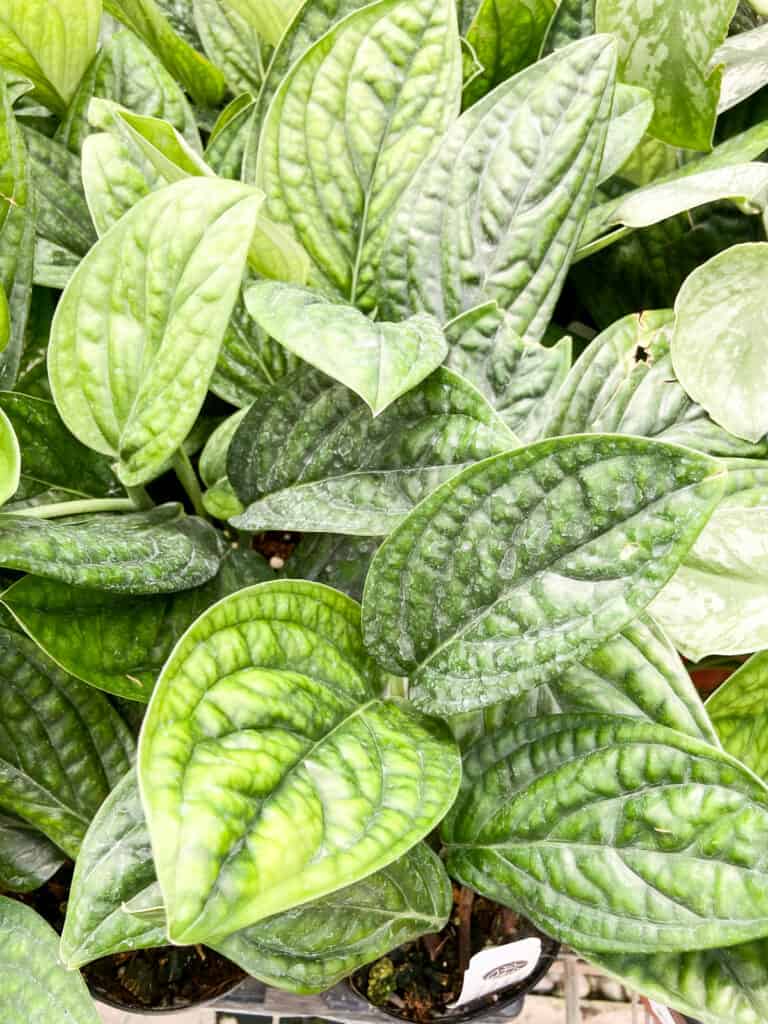The monstera Peru has risen in popularity over the past few years due to its beauty and low-maintenance care. This is a rare member of the monstera genus, so of course you want to make sure you’re giving your plant the best possible care!
With this ultimate care guide, you’ll easily be able to give your Peru a happy home.
Table of Contents
Monstera Peru Plant Background

This post includes affiliate links.
The Monstera karstenianum, or more commonly known as a monstera Peru, is a vining tropical houseplant that is quickly becoming a plant parent favorite. As you can probably guess by its common name, the monstera Peru is native to South America, notably Peru.
The monstera Peru is a member of the well-known Monstera genus of plants, though it differs from its cousins in a few ways. The Monstera Peru leaves aren’t fenestrated, meaning they do not have the signature holes that are the hallmark trait of most monstera plants. The leaves are also much thicker than other Monstera plants and much more rubbery. They’re similar to leaves of a succulent!
The monstera Peru also differs from other monstera due to its slow-growing nature, whereas most other monstera plants have rapid growth patterns. At full maturity, the monstera Peru can reach a length of between 8 to 12 feet, which is actually rather small compared to some other monstera members!
The monstera Peru is an epiphytic plant, which means that it does not grow in traditional soil. Rather, epiphytic plants grow on other plants, most often they will grow on the bark of trees. This allows for air to circulate throughout the root system.
Similar to other monsteras, the monstera Peru is toxic to both animals and humans. It is advised to exercise extreme caution when keeping this plant in the presence of small children and curious pets.
Monstera Peru Care

Let’s move on to Peru Plant care tips and tricks to ensure you’re giving your Peru the perfect care.
Sun & Light for a Peru
The monstera Peru does not require much light in order to live a healthy life. The best light for these Monstera plants is about 4-6 hours of bright, indirect light per day. Avoid exposing this plant to direct sunlight, as this can cause leaf damage.
Soil Type for a Monstera
Keep in mind that the monstera Peru is an epiphytic plant, and requires light, aerated soil to allow for airflow through the roots. You can make your own epiphyte-friendly potting soil by combining equal parts of coco coir, orchid bark, and perlite.
This soil mixture provides the perfect balance of moisture retention and drainage for your Monstera. The ideal pH soil range for this Monstera is acidic to neutral (around 6.0 to 7.0).
Find more monstera soil information here!
How to Water Monstera Peru
Thanks to their fleshy leaves, the monstera Peru can retain water much better than their other Monstera genus members, making this plant quite drought tolerant. The monstera Peru is more susceptible to root rot and over watering, so it is best to allow the potting mix to dry out completely before you water your plant.
When you do water it, you can give it a thorough watering assuming it has good drainage on the bottom.
Fertilizer
During the spring and summer, your Monstera will benefit greatly from a regular fertilizer routine. Select a fertilizer that is mild with a balanced NPK ratio. Apply this to your plant every 3 to 4 weeks for the duration of its active growing period. All fertilization should be stopped in the fall and winter.
Temperature & Humidity for Monstera Plants
As a tropical plant, the monstera Peru enjoys a warm, humid climate. For temperature, try to maintain an indoor temperature between 60° to 85° F. In addition, try to maintain a humidity level that is above 50%.
Many plant owners like to keep their monsteras in locations that are naturally warm with high humidity, such as in a bathroom or the kitchen. If you find you can’t keep the humidity levels high enough for your Peru, you can also opt to place an electric humidifier nearby.

Pruning & Maintenance for Your Peru
The monstera Peru is a relatively slow-growing member of the genus, therefore pruning isn’t a necessity for this plant. However, some plant owners prefer to prune their monstera in order to control its size.
The monstera Peru will inevitably grow to a mature size of 8 to 12 feet tall. If you’d prefer to have a smaller, more compact Monstera plant, then pruning will be in your best interest. Using a pair of sterile, sharp pruning scissors, make a cut above the leaf node to curtail your plant’s growth rate.
In addition, it is always a good idea to prune any dead of damaged foliage that appears on your plant.
Choosing a Container & Repotting a Monstera Peru
Due to its epiphytic nature, drainage plays a huge role in selecting a plant pot for your monstera. Making sure that your plant pot has multiple drainage holes will help allow excess moisture to escape from the pot, which keep your Monstera comfortable in its container.
Trapped moisture is the leading cause of root rot in these plants, and a well-draining plant pot is a huge help in preventing root rot from ever occurring.
As we’ve previously stated, the monstera Peru is a slow-growing plant, meaning you will only have to repot this plant every 2 years. When repotting, size up your planter gradually, selecting a planter that is about 1 to 2 inches larger than the previous one.
How to Propagate a Monstera Peru
Luckily for Mosntera plant owners, the monstera Peru can be easily propagated via stem cuttings. The monstera Peru is an exceptionally rare member of the Monstera genus.
Propagating this rare Monstera will allow you to create multiple copies it. You can keep these new Monstera plants for yourself, gift them to loved ones, or start a small business and become a plant breeder.
Follow these steps to propagate your monstera Peru:
- Take a mature, healthy stem cutting from your plant, cutting right below the plant node. This stem must be at least 4 inches in length and contain at least 3 or 4 plant nodes.
- Remove the lower few leaves, exposing the plant nodes. Allow 1-2 leaves at the top of the cutting.
- Fill a small jar with water and place the cut-end of the stem in the jar, submerging it in water. The remaining leaves from the cutting should stay above the rim of the glass, which provides airflow for the cutting to root.
- Place the jar in a location that receives bright, indirect light. Once a week, replenish the water in the jar to prevent the risk of rot.
- Within 3 to 4 weeks, you should be able to see small white roots growing from the stem. The roots must be one inch in length before they can be transferred.
- Transfer the cutting into a pot with moistened, well-draining soil. For the first couple weeks, maintain a steady level of moisture to help mitigate the risk of transplant shock.
Common Pests in Monstera
The monstera Peru is unfortunately susceptible to the most common household pests, including fungus gnats, mealybugs, scale, whiteflies, and spider mites. While finding pests on your plant can be devastating, there are easy, natural methods to treat an infestation.
Early detection is key. It is recommended to inspect your plants on a regular basis to make sure that they are happy and healthy. Some pests (such as spider mites) and so small that you may not notice their presence. Instead, you may notice damage that they leave behind on the plant’s foliage.
If you do notice signs of pests, immediately quarantine your plant from any other plants nearby. Many plant owners swear by neem oil, which is a natural insecticide. Spritzing your plant with this oil can help control a pest infestation; continue to treat your plant until all signs of pests have disappeared.
Common Diseases in Monstera
The most common disease associated with the monstera Peru is root rot. Root rot is a fungal root disease that commonly occurs in overwatered plants. As we’ve discussed previously, the monstera Peru does not enjoy wet, compact soil. A lack of drainage and too much water are a recipe for disaster.
Luckily, root rot can be treated if approached correctly. Follow these steps in order to treat root rot in your monstera Peru:
- Remove your plant from its pot; shake the potting soil loose to expose the roots.
- Thoroughly inspect the roots and assess the situation; healthy roots are firm and white in color, whereas rotted roots are soft and black in color.
- Using a sterile pair of shears, clip away any signs of rotted roots.
- Repot your monstera in a sterilized container with aerated, well-draining soil, please check to make sure your plant pot has multiple unobstructed drainage holes.
Moving forward, always remember to water your monstera Peru properly. These plants are drought-tolerant and should only be watered when the soil has dried out completely.
Where to Buy
FAQ
Yellow leaves are an indicator that either your monstera is not receiving adequate sunlight, or that it is getting too much water.
Keep in mind that the monstera Peru enjoys bright, indirect light for about 4 to 6 hours daily. In addition, allow the potting mixture to dry out completely before you water your plant.
These are signs that your plant is receiving too much harsh sunlight. Please keep in mind that your monstera should be placed only in indirect light. Direct sun rays can damage the leaves irreparably.
Owning a monstera Peru is definitely something special; they are rare plants and need to treated with the utmost care! Luckily, caring for a monstera Peru is surprisingly very easy and the monstera Peru make a great houseplant for newbies. It takes minimal effort to have a beautiful, tropical houseplant in your home.
Wants other Monstera plant care guides? Head to one of these:

